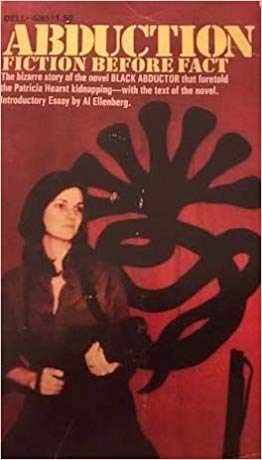
Here’s an astonishing example of an author tuning into the future providing details of an event that would take place two years later. We wrote about this one here many years ago, but it’s worth taking another look at it, and considering the question of whether or not this fictional story created that actual event or did the author tune into what was to come.
In 1972, Regency Press published a novel, Black Abductor, by Harrison James, a pseudonym for James Rusk Jr. It’s about a terrorist group led by a black man who kidnapped a college student, Patricia. Her wealthy father was well known and had right-wing sympathies.
In the novel, Patricia was kidnapped near campus while she was with her boyfriend, who was badly beaten by the abductors. For a while, the boyfriend was a suspect in the case. The fictional Patricia initially resisted her captors, but eventually subscribed to their ideology and became a champion of their cause. The terrorists sent Polaroid photos to her father and described the abduction as America’s “first political kidnapping.” They predicted they eventually would be surrounded by police, tear-gassed, and wiped out.
Two years after the book was published, in 1974, Patricia Hearst – daughter of newspaper baron Randolph Hearst and then a college student – was abducted from her apartment near campus. The kidnappers were members of the Symbionese Liberation Army, a terrorist group led by a black man. Her boyfriend, Steven Weed, was with her at the time and was badly beaten, but became a suspect in the case. Patricia Hearst, like the fictional Patricia, became a sympathizer of her abductors’ cause. She ended up robbing a bank with her kidnappers and was photographed carrying an MI carbine.
The FBI was either familiar with the novel or had read it and the author became a suspect in the case. The real abductors were eventually surrounded by the police, tear-gassed, and killed, just as the fictional kidnappers predicted they would be. All of this begs the question: had the terrorists read the novel? Or was this an instance where the author’s creative edge enabled him to sense the future so deeply that he uncovered stunning details identical to those that came about two years later?
Realistically, would anyone read a novel with such a deadly plot and decide to duplicate it? Maybe. But it would be challenging to get the boyfriend to play the appropriate role and the authorities to do the same. Most likely, Rusk, through his creative endeavor, had somehow tuned into an event yet to come.
Two years later, playing on the similarity of real life events, the book was republished with an essay introducing it. That’s it in the image above. The author James called the similarities of the two stories a ‘coincidence.’ He also seemed somewhat embarrassed by the attention the book was getting, including interest from the FBI, and he notes on Amazon.com that the book was not only extremely violent, but also pornographic. He said the only reason it rated three stars on Amazon is because of the coincidence.
One other note, I initially was going to call this post by the title of the book, Black Abductor. But it occurred to me that it would be bad form to repeat the provocative title, which plays on race. I doubt that any mainstream publisher would play on the word ‘black’ as was done in 1972.








Great story! I wonder how often this happens…
In science fiction it happens a lot.